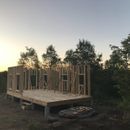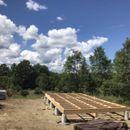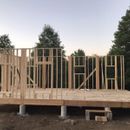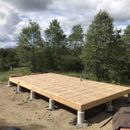Raised Subfloor Wet Insulation
Hello, I just joined the community and thanks in advance for your help. I’m a new builder taking on my first big project.
I’m building a 16×32 cabin on 15 cement piers in Vermont. I’m working with green rough cut hemlock. The subfloor is constructed with 2×12 joists and doubled up rimmers. We insulated the subfloor with 12 inch faced R38 fiberglass before installing Advantech on top. We chose to leave the bottom open until next summer to be sure the green lumber can dry out and prevent trapping moisture in the subfloor.
The issue is that we’ve had several heavy rain storms recently and water is penetrating through the subfloor. There isn’t a ton of rain leaking but the insulation is damp in places at the top of the joists. Additionally, the wood is very green and I think this is contributing to the moisture. When I crawl under the subfloor and stick my hand up to the top of the insulation, it is quite damp in spots. My primary concern is wood rot/ mold and secondary concern is the insulation deteriorating.
The roof should be up by next week. My question is should I tear out the fiberglass insulation so I’m sure the subfloor and joists can dry out and cut my losses? Or do you think the joists and insulation can dry out with a roof on and the bottom open? If this seems like an option, I’d put plywood or Zip system on the bottom of the subfloor to vapor seal it next spring.
If I rip the insulation out, does it seem feasible to insulate it from the bottom? I don’t want to rip any of the Advantech up. My plan would be to place mineral wool, 2 inches of rigid foam insulation and then zip system or pressure treated plywood, but this will be obviously tough fighting gravity.
Curious your thoughts. Also interested in advice on putting skirting around the cement piers and weather I should seal the joists to protect from rot. The joists are 18 inches of the ground except for the center rimmer which is 8 inches of the ground.
thanks – Colin
GBA Detail Library
A collection of one thousand construction details organized by climate and house part













Replies
Near term, I'd pull out the insulation until your roof is on and the cabin is "dried in."
Long term, you need to protect the floor cavities from critters and weeds. Water, vapor and heat loss are easy by comparison. If you can't get a layer of plywood or fiberboard nailed and sealed to the bottom maybe jack the whole thing up? Other options will be fussy and less effective: sealed membranes, aluminum roll screening, hardware cloth...I'd opt for plywood and a fluid-applied air barrier.
Best,
j
Hey J,
Thanks for the reply. So you don't think the insulation has the potential to dry out? We will have a roof up next week and if this is salvageable I'd rather not have to re-do the insulation. I'm not building LEED, just a cabin for myself.
I can nail plywood underneath next spring when the wood joists are fully dried out.
Any advice on putting skirting around the cement piers and weather I should seal the joists to protect from rot. The joists are 18 inches of the ground except for the center rimmer which is 8 inches of the ground. Thanks!- Colin
It's hard to say, but I do know that drying through insulation takes a lot longer. Wood can handle some of the bulk water punishment, but not trapped in fiberglass. I think you're running the risk of mold. Redoing work isn't fun but I suspect it's easier than abatement!
I've seen at least one article on this site regarding skirting. You don't need it if you have other means of winterizing the plumbing and keeping pests out of the floor cavity. Your rim joists should be properly clad. The area directly over concrete piers looks like a spot snow will collect and rain will splash back, leading to deterioration of the rim at those locations.
https://www.greenbuildingadvisor.com/article/crawl-spaces-vs-skirts